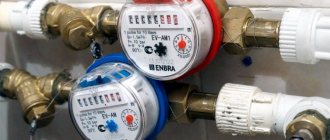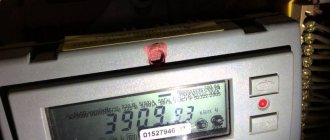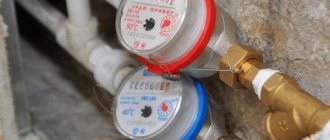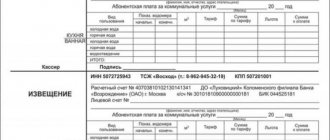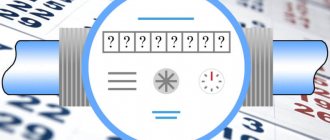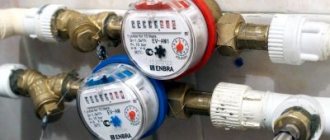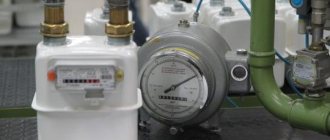An electricity meter in an apartment or house helps control the consumption of electrical energy. The homeowner is responsible for monitoring the technical condition of the device, carrying out repair work and submitting an application for periodic inspection. Below we will discuss the frequency of verification of electricity meters and how household electricity meters are verified without removal. Also, the reader will learn about what the verification interval is and who should carry out the scheduled verification.
Electric meter service life
The answer to the question, what is the service life of the electric meter, is in the device passport. Here the manufacturer indicates the model and expiration date. To measure electricity consumption in an apartment, two types of meters are used: induction and electronic.
Induction Electricity Meters
An induction meter works on the following principle: electricity moves through a roller, forming a magnetic field. Under the influence of the field, the disk rotates and the readings are displayed on the display. The higher the power of the devices connected to the network, the faster the disk will rotate. The service life of an induction type electric meter is indicated in the technical passport and is 30 years. The same document states how long it takes to replace electricity meters with new ones.
A device operating on electromagnetic induction does not give accurate readings because it has a low accuracy class. The second point concerns the possibility of deceiving the meter and distorting the readings if the magnet is brought closer to the disk. Under the influence of the magnet, the rotation slows down and the readings decrease.
In 2021, energy supply companies made a decision related to the replacement of all devices of class 2 and lower.
Electronic electricity meters
Electronic meters do not contain moving parts in their design. With this in mind, it is impossible to fool them by applying a magnet. The accuracy of the instruments is at a high level. The service life of an electric meter is 25-30 years.
Hybrid electricity meters
The product data sheet does not contain the word hybrid, but the design contains both mechanical and electronic parts. The cost of a hybrid meter is more affordable than buying an electronic version. Because of this, many people prefer to purchase this type of device.
What is verification and why do it?
What is verification? First of all, two words are very close in pronunciation: verification and verification, but they mean different results of actions.
Checking the electric meter is carried out to determine the technical condition of apartment appliances, correct connection and proper operation of the equipment. At the end of the check, the user is given an act or certificate, which must be transferred to the energy company.
Routine verification of electric meters is carried out to confirm that the technical and metrological characteristics of the device meet the requirements. It is impossible to carry out the verification yourself. This requires special knowledge, equipment and a qualified specialist.
Verification of household electric meters is carried out only in certain cases:
- The previous state verification period has expired.
- Before installing a new meter. The installed device undergoes initial verification so that users are confident that the equipment is working correctly.
- According to user's requirement. An unscheduled verification of the electricity meter becomes necessary if a large number of kilowatts were noticed, even with electrical appliances turned off.
- To restore lost documents on the counter.
Attention, the user must monitor the verification deadlines. If the verification deadlines are missed, the meter readings become invalid. In this case, from the end of the period until the day of verification, the calculation of the amount and cost of consumed electricity is carried out at average tariffs.
What to do if the MPI has expired
How to understand that the meter needs to be replaced.
If your electricity meter has expired, you need to contact your utility service provider. A written notification is drawn up about the need to diagnose IPU. During device research, fees for resource consumption will be charged based on average indicators.
If the IPU is not verified and installation is not carried out within 3 months, then receipts will be issued in accordance with the standards relevant in the consumer’s region of residence. Each subject of the Russian Federation has separate regulations for such cases. Experts recommend purchasing a new sealed electric meter, since in most situations, after diagnostics, the non-working state of the old IPU becomes clear.
How often should the meter be checked?
The timing of the verification interval of the electric meter is prescribed in the product passport. In addition to the device, a report and certificate on the results of the initial verification examination are given, which also indicates the date of the next verification.
As a rule, electric meters need to be checked every 6–15 years. Depending on the type of measuring device, the MPI (calibration interval of electric meters) is established. For induction type, verification must be carried out every 8 years. The frequency is indicated by the manufacturer himself, specifying how long the equipment will operate without errors or errors. A meter that has expired is considered unfit for use until the contrary is confirmed by laboratory testing. The frequency of inspection of measuring equipment may change due to emergency situations.
Calculation of consumed electricity can only be carried out using a special meter that has a passport, certificate, and evidence of its compliance with current state standards.
Verification nuances
When installing a device for metering consumed utilities, it is necessary that the owner of the facility trusts the IPU, as well as the RSO. Based on this information, the institution will issue invoices for payment.
Thus, all parties to this process must be confident in the correctness of the transmitted evidence. In view of this, when purchasing and installing a meter, experts recommend finding out about the presence of a certificate and accreditation from the manufacturer. Direct installation should be ordered from authorized companies.
The calibration interval of the electric meter has features depending on the installation location - a private household or an apartment in an apartment building.
Watch the video: “Checking electricity meters. How to save money and time."
In a private house
Often in private households, meters that monitor energy consumption are installed on the street. However, this is not a basis for refusing to provide evidence, verify the IPU or agree with the issued receipts.
It is noteworthy that the more complaints the owner sends to the RSO, the more correctly settlement transactions are carried out. But in order to make claims against the company, you must, on your part, comply with the assigned responsibilities, namely: check electricity meters on time.
In addition, the owner of the house must provide RSO employees with the opportunity to:
- verify readings;
- control the integrity of the seal;
- keep honest records within the framework of the law.
Requirements from RSO are also imposed regarding the location where the electric meter will be located. In particular, they relate to compliance with temperature conditions and humidity levels.
In the apartment
The owner of the apartment is not obliged to independently verify electricity meters. Such procedures are carried out by the RSO or the company servicing the apartment complex, according to the established tariff. Directly taking readings and monitoring the performance of the device is free of charge. Analysis of the technical parameters of the IPU costs money - it takes into account the period and current standards.
At the installation site without removal
Verification of the electric meter without removal is carried out by a device for testing and comparing the measured energy due to the frequency of pulse outputs.
The consumer sends an application to a metrological institution or an accredited company to carry out maintenance of the IPU without dismantling. According to the received request, an employee of the organization comes to the address with the appropriate equipment. Experts recommend submitting an application 1.5-2 weeks in advance to avoid missing the verification interval.
Thanks to the mobility of the system, companies can check without removing the device. The equipment used allows you to analyze resource consumption with an error below 0.01%. The devices used are single-phase and multi-phase, low or high power.
Calibration equipment analyzes the operation of individual elements of the IPU. This allows us to identify the correct distribution of errors among parts of the mechanism. The result of the work is influenced by the ratio of the test load on all meter sensors.
In other words, if the indicators are not the same or have inaccuracies, then there is a significant error in the operation of the electrical appliance. In this case, a malfunction is diagnosed and the owner needs to install a new electric meter.
How is the measuring device verified?
Currently, two verification options are used:
- in the laboratory;
- at the location of the device.
The first verification method is carried out in a specialized laboratory. This process takes at least 14 days. On average, it takes from 2 to 4 weeks to obtain measurements and issue a certificate. In addition to the long time, verification in the laboratory has a considerable cost.
This is what the price for verification in laboratory conditions consists of:
- audit;
- dismantling and installing the meter;
- transportation to the place where electricity meters are checked, and back to the place where the device is located.
Of course, not every user can handle the financial costs and deadlines. Therefore, a more popular option is verification directly at the installation site of the measuring device. The audit requires special equipment.
Responsible employees of the energy sales company ensure that the meter requires verification. Direct verification is carried out by specialized institutions operating in accordance with the obtained licenses and certificates.
Company specialists use several types of control devices in their work, with the help of which the temperature conditions of the measuring device and the measurement error are taken into account. Modern technologies make it possible to carry out audits using a computer. The received data can be stored for a long time and restored if necessary.
An independent examination of the electric meter is carried out only in emergency situations, for example, a fire. In this case, the laboratory determines whether the cause of the incident was faulty wiring or a short circuit in the network.
Who should carry out scheduled verification
When a citizen applies for diagnostics to a non-state enterprise, it is necessary to check the accreditation certificate for expiration date. Concluding a contract for the provision of services is a mandatory condition. In this case, the text of the document must include information that the company will carry out interval verification of the electricity meter. If you refuse to prescribe such a clause, experts recommend turning to another contractor.
The apartment owner also needs to take into account that in most cases the procedure is carried out with the removal of equipment. In view of this, the owner of the premises is obliged to send a notification to the management company or RSO about the upcoming work, since during this process the seal is destroyed. Such actions are allowed to be carried out only after the official recording of the testimony. Otherwise, the enterprise or management company has the right to review the procedure for calculating fees for the consumed resource during the specified period.
Actions when checking the meter
What devices will be used for the audit depends on the type of measuring device installed.
The process can be divided into stages:
- Visual inspection. The specialist carefully inspects the meter for mechanical damage, deformation of the housing or additional elements. The device number, compliance with state standards of configuration and labeling are also checked.
- Strength test. At the same time, the insulating elements are checked. This stage of the audit is not carried out for the following devices: only purchased equipment, meters after repair (since the insulating elements were already checked during the process), devices with unbroken sealing.
- It is checked how correctly the counting mechanism functions. The device is connected to the power supply network for a while, and the equipment is warmed up for 15 minutes. At the same time, the specialist controls the energy supply mode and voltage so that the data is within normal limits. During the specified time, the frequency indicator of disk rotation is measured.
- It is necessary to confirm that there is no self-propelled device in the meter. To do this, the device is connected to electricity via a parallel circuit. The voltage in the circuit is 115% of the nominal value. In this case, no voltage is supplied to the series circuit. The study lasts 10 minutes. If the design of the measuring instrument does not allow for self-propelling, then this item is skipped.
- Checking the sensitivity threshold. The study lasts 10 minutes, during which the device is supplied with rated voltage through a parallel circuit.
At the same time, actions are taken to monitor the error in the device (relative and basic). They must correspond to the values indicated by the developers of this equipment. Based on the data obtained, the deviation is calculated. During error studies, a stopwatch and a current and voltage meter are used.
The verification process ends with sealing of the measuring equipment. To do this, a stamp imprint is left on the seal being installed.
It is worth mentioning the features of checking different types of electricity meters in an apartment:
- simple devices are controlled by checking electronic accuracy;
- More complex equipment, such as three-phase equipment, requires more time and step-by-step inspection, during which electronic accuracy is determined and additional capabilities are analyzed.
If during verification by metrological organizations it was determined that the meter does not meet the requirements, or its malfunctions do not allow further use of the device, then the measuring equipment is replaced with new one. Such a solution will be in the interests of the user himself, since when installing a new meter, the amount of electricity consumed will correspond to reality.
Electric meter verification procedure
The verification period for the electricity meter is controlled by the owner of the apartment or private house. The obligated citizen must independently agree on the date of transfer of the device for diagnostics and deliver the IPU to the address of the metrological center. However, at the legislative level, conducting verification without removal is an acceptable procedure if the contractor has accreditation.
Don't understand the article or need help? Ask our in-house lawyer a question through the Online Consultant form or leave a comment. We will definitely answer!Ask a question >>>
Step No. 1: Analysis of the correct connection of the electric meter
The use of a control device depends on the type of IPU and the number of phases. On the diagram this can be reflected as two connected inputs - zero and phase, as well as the point of connection with the load circuit.
The controller can diagnose problems with the electric meter by identifying additional sources of connection to the network. In the second case, suspicion may be caused by a violation of the connection sequence.
Deviations from the norm are grounds for additional verification, since such cases often indicate theft of resources through unauthorized connection. The correctness of the connected individual energy consumption device is carried out by simple inspection.
Step #2: Self-propelled research
The concept of “self-propelled” meter means circumstances under which the device disk rotates without additional load, i.e., on its own and at the same time all electrical appliances are de-energized. After turning on all the diverter automation, the controller observes the movement of the mechanism for 7-10 minutes.
If the device is working properly, then rotation will not occur, and the indicator will not show more than one pulse. In the opposite situation and a flashing sensor, the procedure ends with re-verification or installation of a new IPU.
Step #3: Gear Ratio
The gear ratio is set on the external panel of the electric meter. The coefficient provides information to the consumer and the RSO about the number of revolutions or blinks - the type of reading depends on the type of device.
Based on the rotation of the disk or electronic indicator, the consumed resource is calculated. In other words, these figures act as indications for calculating electricity - 1 kilowatt is equal to the approved tariff in the region.
Step #4: Establishing the error
Another necessary stage of conducting an inter-interval check of the electric meter is error diagnosis. The event is conditioned by establishing the correctness of the transmitted readings.
Step #5. Detection of meter magnetization
A pressing question for consumers is how often the electric meter is checked for magnetization. The topic is of interest to those property owners who have an old-style disk device installed. The new generation of IPUs are created on the basis of induction and have a protective seal that changes color when interacting with a magnet. Verifications of this type are required by the RSO to be carried out no more than once every six months.
An analysis of the magnetization of an individual consumption device can be carried out using a regular needle - if it is attracted to the equipment, then, therefore, the IPU has a strong magnetic field. It is noteworthy that such circumstances work both to the consumer’s advantage and to the disadvantage. That is, prohibited devices will not slow down, but, on the contrary, will accelerate the rotation of the disk, which means the owner will pay more.
Verification period
The timing of verification of electricity meters depends on the specifics of the procedure, i.e. whether the IPU needs to be removed or not. In the first case, a thorough diagnosis and issuance of a result on the possibility of operation will be required. This procedure can take several hours or 2-3 days.
If the inter-verification analysis does not require dismantling the electric meter, then the defining parameters are:
- diagnostics of the nominal voltage in the network - takes about 15-20 minutes;
- checking the fact of “self-propelled” – this will take 10-20 minutes;
- 10 min. an inspection is performed to ensure that there are no physical defects on the IPU;
- additional time is spent completing the report on a special form and sealing the meter.
What verification procedure is established?
The main body entrusted with the functions of consumption accounting and verification of measuring equipment is the Metrology Standardization Center. Each region has its own branch of the Center.
The owner is responsible for performing the procedure if the verification takes place in the laboratory. The owner is obliged to deliver the measuring device to the department or branch of the Metrology Standardization Center and agree on when the verification will be carried out. On the part of Energosbyt there must be control over the timing of verification of devices, and when the date approaches, the owner of the equipment must be informed that an audit is necessary.
If the user has doubts about the reliability of the meter readings, he has the right to contact the organization performing the verification before the expiration of the previous audit.
Regulations for consumer actions to check the electric meter at home without removing it:
- Make a call to the company that deals with verifications. By telephone, leave a request for an inspection of the measuring device, without removing the latter.
- After the metrologist carries out the verification, the user is given a package of documents, which includes a meter verification report. The received papers must be taken to the energy supply company operating in the consumer’s area of residence.
- After the specialists of the energy supply organization check all the documents for correctness and accuracy of the data, a Distribution Zone employee comes to the address where the electricity meter is installed and seals the meter. As soon as the seal is installed, the electrician must rewrite the readings of the device.
Verification is carried out using special tools and equipment. If there are minor deviations, the technician can perform calibration on site and restore operation. If everything works correctly, there are no deviations or violations, then the meter is sealed again and a certificate is issued.
Simplified system for inspecting an electric meter without removing it
More recently, a service has appeared in Russia that is designed to significantly facilitate the process of checking the electric meter after the expiration of the MPI. The procedure is as follows:
- The energy company receives a statement stating that the meter needs to be unsealed. The procedure is formal; no one appears on the doorstep to remove the filling.
- Contact an accredited company that has a license to operate and fill out an application for simplified verification. Before contacting a company, you should find out everything about it, since there is a great danger of falling for scammers.
- Money is deposited into the organization's cash desk for a package of documents.
- After payment has been received, the documents are sent by mail to the consumer.
- The user takes the package of papers to the energy supply company.
- In return, the company issues a certificate of ownership. After this, you can go to the RES and write a request to seal the device.
The service life of the meter is indicated in the technical data sheet for the product. On average, the shelf life ranges from 25 to 32 years.
The calibration interval for electric meters is specified in the documents given by the electrician after the meter is installed and sealed. On average, verification is carried out every 4, 6, 16 years (depending on the type of measuring device).
